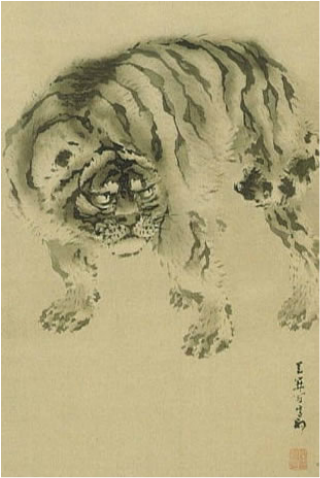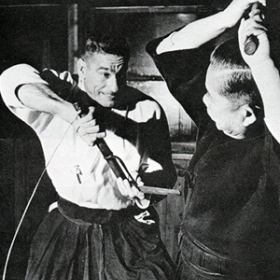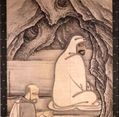I do remember an exception while a senior instructor working with another Westerner and I at one end of the dojo while Shimizu Sensei seemingly absorbed with the seniors at the other end of the dojo quite powerfully “communicated” to the instructor helping us that he was wrong, didn’t know what he was talking about and basically not to screw up the beginners. I don’t know if I was learning the Japanese concept of “face” but I was embarrassed on this man’s behalf and hated being one of the screwed up beginners. Come to think of it, I’m not certain that the teacher ever approached us again.
For others present, I’m not sure if they were more dumbfounded about the energy of the message or that Shimizu Sensei actually said something during training that approached complete sentences. In other articles within this site I’ve talked about training being experiential. Often words just get in the way. Shimizu Sensei understood this intrinsically. I will digress as I often do to add that Shimizu Sensei could read Western body movements and spent little time trying to “beautify” the gross mechanical skills of non-Japanese physiques. Today many teachers try to get Westerners to conform physically in ways that might look more elegant but might also contradict good budo logic. I have noticed over the years that some of my dojo mates want to rely heavily on verbal guidance. Failing that, they have an irresistible urge to find a book, video or U-tube clip to assist in navigating thru the haze that all beginners feel. Here too I’ve noticed that media like verbal explanations seems to fall short of helping the student “understand”. Without a trained eye, what is seen is not nearly as valuable as what was missed. Usually the thing worth seeing is NOT what the new student looks at anyway. This still amazes me and I suspect that it has something to do with under-developed ganriki.[3] There is a direct relationship between those who get frustrated and upset at the lack of verbal support and the ability to progress in budo. This is sad but it is as if the reliance on the mind interferes with the lessons taught through experience. In Japan today there are few schools that teach truly non-verbally anymore. The Japanese don’t often posit questions, being adverse to sticking out individually. They observe, practice and conform. The process initially might seem slower and less efficient to an outsider but it yields results in developing consistent knowledge foundations. No amount of discussion can replace observation. A student must steal the thing being taught. Oral communication no matter how brilliant will never impart skill. Practice will. Rugged individualism has its’ place though. Conformity or perhaps humility is important to learn. Preconceptions on the part of the new student get in the way of learning. If you think you know something then you can’t learn anew and everyone knows but fails to implement the story of the master and the teacup. [4] Letting go is one of the toughest things for a Westerner to do. It is important however to quiet the little voices that emerge during training and place faith in the teacher. Westerners are a competitive lot and we’re never happy with our own performance privately let alone in comparison to our dojo-mates. We are often in too much of a hurry to “know” something and demonstrate verbally that we hold this special truth. In forming an opinion we believe that we have something to say that is worthwhile. A good teacher sometimes blocks this kind of wasteful action and sometimes patiently pretends to accept it. The student should be very cautious about this act on the part of the teacher as more often than not, the teacher that just listens and smiles is neither listening nor smiling. At seminars and in dojo I’ve seen people, seemingly sincere expend huge amounts of energy bracketing an opinion in some humble form. They fail to realize that the essence of the message is being interpreted as they think they have something to offer before they really do. This is especially annoying to the teacher that sees that this person can’t demonstrate what they’re communicating orally. Yep, in my own misplaced exuberance, I’ve fallen into every trap that I’ve listed here. Intellectually we might understand the “Journey” discussion or the metaphor with the full cup of tea but in actuality we just can’t let go of our thoughts and the demons seem to require being assuaged through verbal reinforcement. This crutch is temporal and might make a student feel better in the short term but does not to “fix” how the student should learn effectively in the long term. Once a level of mastery is obtained practice becomes a series of “study-points” where the student with a good foundation can observe and learn more efficiently. It is correct then to challenge the teachings and discussion does have a place at the training table. This might be something that Japanese style instruction could improve upon as well as questions are not part of the culture. There will always be a tension between the student, the group and the teacher as to when the time is right to ask and to challenge but one thing is clear, Westerners do it way too soon. My best suggestion for beginners is that sincere practice reveals most of the answers when the time is ready. That's budo time not our time of convenience. Discussion is wasted energy. Books and media might guide people who already know the topic being highlighted but are virtually useless tools to the uninitiated. Now some of you that know me are reading this and probably shaking your heads. After all I’m not known as a quiet instructor even though I do prefer it. Although this might be an indictment of me it is more a mirror image of you as Westerners trying to learn and to adapt. Cultural differences are a hard thing to grasp. You can spend your entire life trying to understand, appreciate, respect, or even adopt these differences in outlook. About the best a teacher might hope to accomplish is to sensitize the student to move towards the Japanese way of learning to effectively learn a Japanese budo. The rest is up to you. [1] I would add that back in those days I was wholly unaware of any discussions about the fact that culture influences how we learn. This seems obvious now. [2] Years later as I advanced and worked directly with Kaminoda Sensei I was paid a rare compliment of sorts. Sensei said that only Osato Sensei and I could anticipate when he needed something such as a bokken when holding a jo etc. Yuri working as translator also developed an uncanny relationship in being able to parse the translation between Japanese and English in a most effective way and in demonstrating a form of teamwork rarely duplicated with other teachers when translations were required. [3] Ganriki “Eye-power” A budoka can see the experience of another budoka or martial arts practitioner. Kaminoda Sensei used this term referring to Woody and I during a demonstration at Katori Jingu back in the 90’s. Woody had many prior years of karate experience. [4] In essence the student eager to demonstrate what he knows is invited to tea with the teacher. The teacher pours the tea until well after the student protests that the cup is full and tea is being spilled and wasted. The student must realize that he must be an empty vessel to receive instruction.
0 Comments
Leave a Reply. |
AuthorRick Categories
All
Archives
January 2017
|
|
Po Box 232 Severna Park, MD. 21146
|
Copyright © 1996 - 2023


 RSS Feed
RSS Feed






